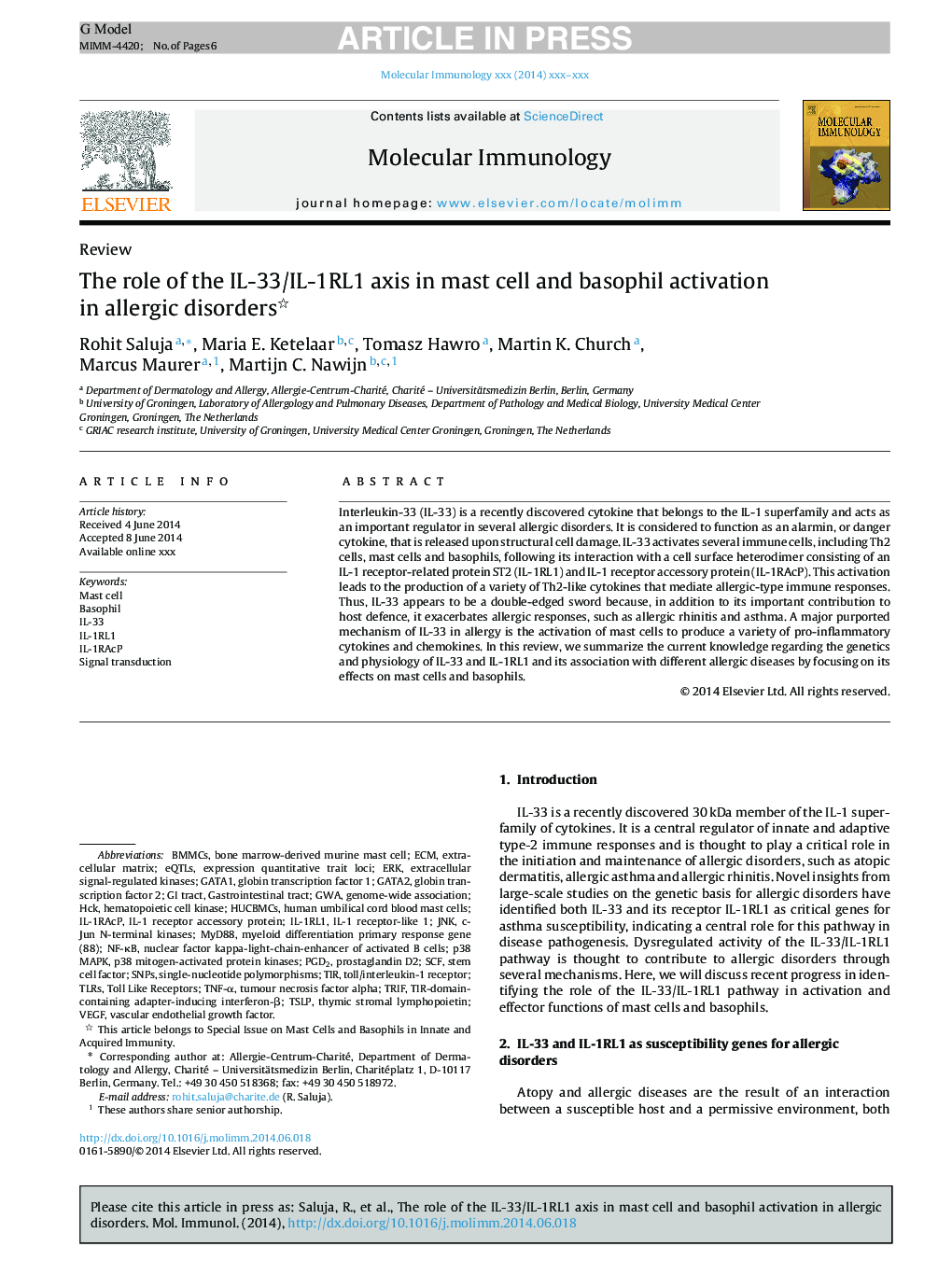| کد مقاله | کد نشریه | سال انتشار | مقاله انگلیسی | نسخه تمام متن |
|---|---|---|---|---|
| 5916834 | 1163757 | 2015 | 6 صفحه PDF | دانلود رایگان |
عنوان انگلیسی مقاله ISI
The role of the IL-33/IL-1RL1 axis in mast cell and basophil activation in allergic disorders
دانلود مقاله + سفارش ترجمه
دانلود مقاله ISI انگلیسی
رایگان برای ایرانیان
کلمات کلیدی
JnkSCFBMMCsGWAERKPGD2SNPsMYD88IL-33eQTLsIL-1RAcPTSLPGATA1NF-κBGATA2ECMc-Jun N-terminal kinases - C-Jun N-terminal kinasesp38 MAPK - P38 MAPKTLRs - TLR هاTRIF - Trif بهGenome-wide association - انجمن گسترده ژنومTIR-domain-containing adapter-inducing interferon-β - اینترفرون-β، باعث القاء آداپتور حاوی دامنه TIR می شودbasophil - بازوفیلExpression quantitative trait loci - بیان صفات صفات کمیtumour necrosis factor alpha - تومور نکروز عامل آلفاTIR - تیرGastrointestinal tract - دستگاه گوارشGI tract - دستگاه گوارشVascular Endothelial Growth Factor (VEGF) - فاکتور رشد اندوتلیال عروقی (VEGF)vascular endothelial growth factor. - فاکتور رشد اندوتلیال عروقی.Stem Cell Factor - فاکتور سلول بنیادیTNF-α - فاکتور نکروز توموری آلفاnuclear factor kappa-light-chain-enhancer of activated B cells - فاکتور هسته ای kappa-light-chain-enhancer از سلول های B فعال شده استThymic stromal lymphopoietin - لنفوپیتین استروما تیمیکExtracellular matrix - ماتریکس خارج سلولیMast cell - ماستسلToll like receptors - مانند گیرنده هاSignal transduction - هدایت سیگنالHck - هکIL-1 receptor accessory protein - پروتئین افزودنی گیرنده IL-1p38 mitogen-activated protein kinases - پروتئین کیناز متیوژن فعال P38Prostaglandin D2 - پروستاگلاندین D2Single-nucleotide polymorphisms - پلیمورفیسم تک نوکلئوتیدیmyeloid differentiation primary response gene (88) - ژن پاسخ اولیه تمایز میلوئید (88)hematopoietic cell kinase - کیناز سلولی خونریزیextracellular signal-regulated kinases - کیناز های تنظیم شده سیگنال خارج سلولیToll/interleukin-1 receptor - گیرنده Toll / interleukin-1
موضوعات مرتبط
علوم زیستی و بیوفناوری
بیوشیمی، ژنتیک و زیست شناسی مولکولی
زیست شناسی مولکولی
پیش نمایش صفحه اول مقاله

چکیده انگلیسی
Interleukin-33 (IL-33) is a recently discovered cytokine that belongs to the IL-1 superfamily and acts as an important regulator in several allergic disorders. It is considered to function as an alarmin, or danger cytokine, that is released upon structural cell damage. IL-33 activates several immune cells, including Th2 cells, mast cells and basophils, following its interaction with a cell surface heterodimer consisting of an IL-1 receptor-related protein ST2 (IL-1RL1) and IL-1 receptor accessory protein (IL-1RAcP). This activation leads to the production of a variety of Th2-like cytokines that mediate allergic-type immune responses. Thus, IL-33 appears to be a double-edged sword because, in addition to its important contribution to host defence, it exacerbates allergic responses, such as allergic rhinitis and asthma. A major purported mechanism of IL-33 in allergy is the activation of mast cells to produce a variety of pro-inflammatory cytokines and chemokines. In this review, we summarize the current knowledge regarding the genetics and physiology of IL-33 and IL-1RL1 and its association with different allergic diseases by focusing on its effects on mast cells and basophils.
ناشر
Database: Elsevier - ScienceDirect (ساینس دایرکت)
Journal: Molecular Immunology - Volume 63, Issue 1, January 2015, Pages 80-85
Journal: Molecular Immunology - Volume 63, Issue 1, January 2015, Pages 80-85
نویسندگان
Rohit Saluja, Maria E. Ketelaar, Tomasz Hawro, Martin K. Church, Marcus Maurer, Martijn C. Nawijn,